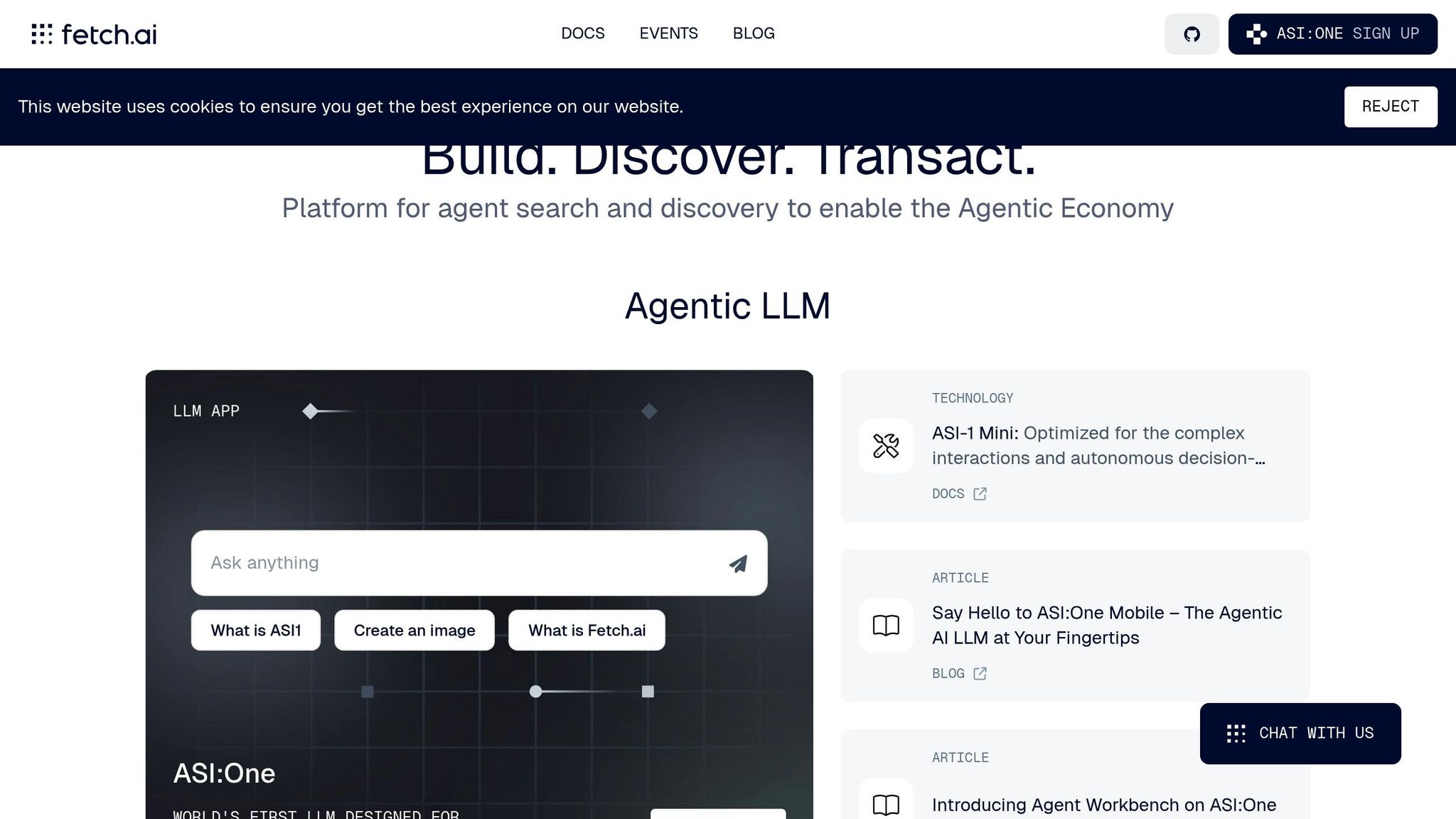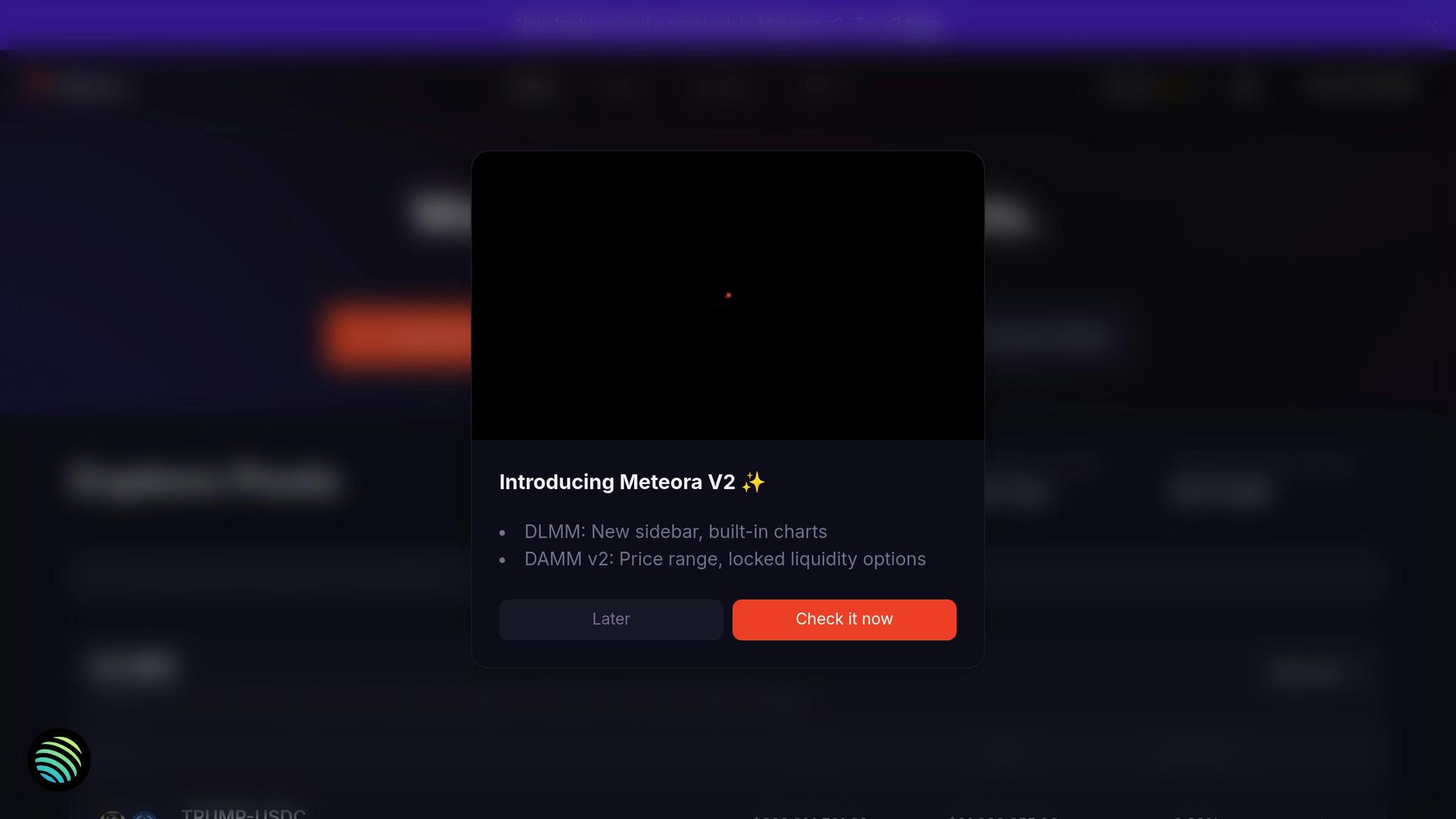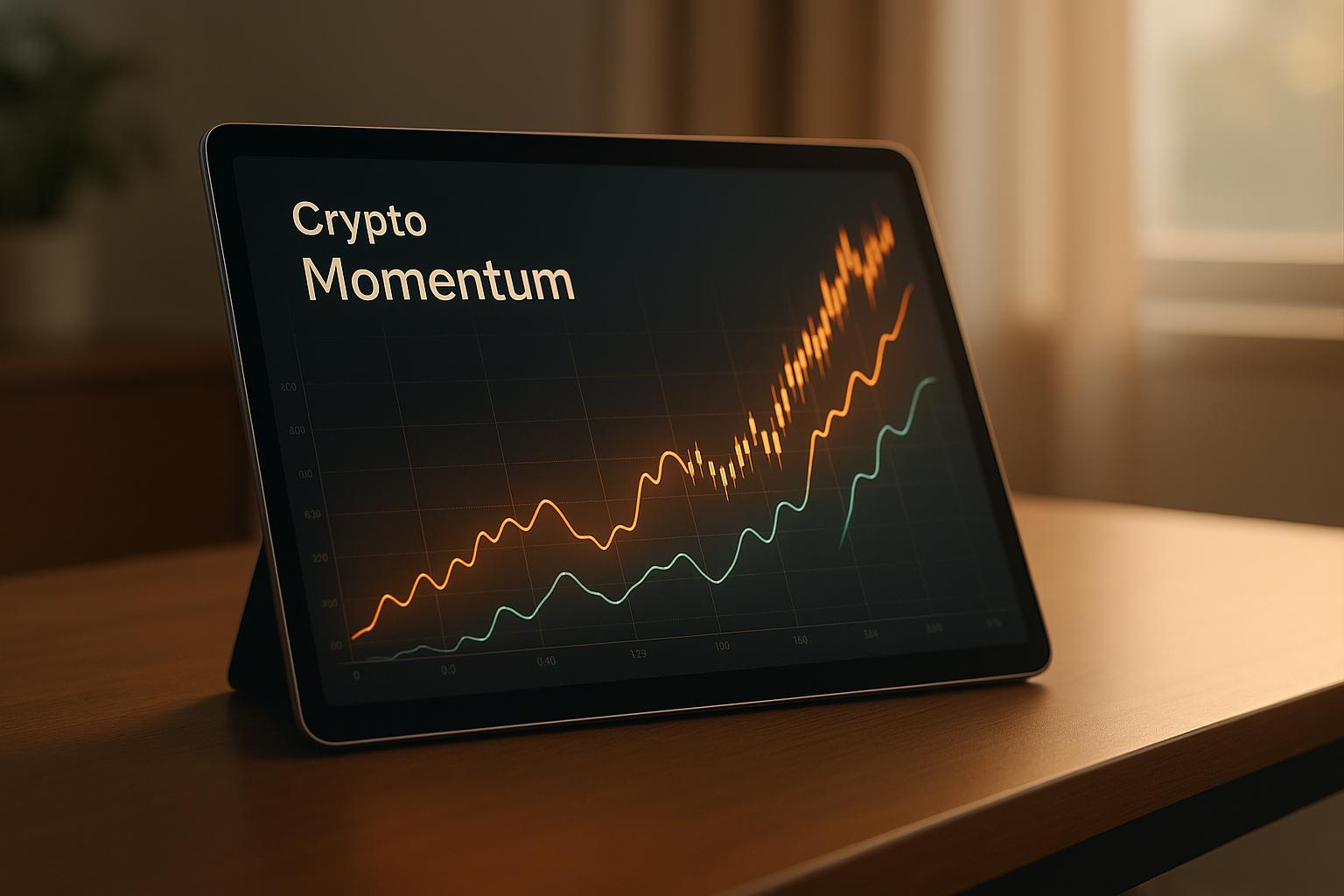AI tools are transforming how liquidity pools operate in DeFi, making them smarter and more efficient. Here's what you need to know:
- Fetch.ai uses autonomous agents to adjust liquidity dynamically, reducing slippage by 35% and MEV attacks by 50%.
- Meteora focuses on Solana, offering real-time fee adjustments and managing over $1.1 billion in TVL.
- Arrakis Finance automates liquidity management on Ethereum, managing 25% of Uniswap V3's liquidity.
- AIQuant.fun supports multiple blockchains (Base, BNB Chain, Solana) with tokenized AI agents for 24/7 liquidity optimization.
Quick Comparison:
| Platform | Key Features | Blockchain Support | Best For |
|---|---|---|---|
| Fetch.ai | Agent-based automation, slippage reduction | Multi-chain (Ethereum, Cosmos, etc.) | Advanced AI-driven strategies |
| Meteora | Solana-specific optimization, dynamic fees | Solana | Solana-focused users |
| Arrakis Finance | Concentrated liquidity, automated management | Ethereum | Protocol-owned liquidity |
| AIQuant.fun | Multi-chain AI agents, cross-chain support | Base, BNB Chain, Solana | Multi-chain liquidity |
Bottom Line: Choose Fetch.ai for agent-based innovation, Meteora for Solana-specific tools, Arrakis for Ethereum liquidity, and AIQuant.fun for multi-chain flexibility.
What Is Aperture Finance? AI Powered Intents for DeFi
1. Fetch.ai

Fetch.ai has carved a niche in AI-powered DeFi optimization, leveraging autonomous agents to fine-tune liquidity pools. By automating complex tasks, the platform minimizes human errors and reacts to market shifts faster than manual methods.
Liquidity Optimization Features
Fetch.ai's DeFi Agent actively manages liquidity pools on platforms like Uniswap V2 and PancakeSwap. It monitors predefined conditions and withdraws assets when profitability risks arise, helping to address the challenge of impermanent loss - a significant concern for liquidity providers.
The platform also employs AI-driven strategies to regularly rebalance portfolios. This ensures users can capture the best yield opportunities while reducing exposure to volatile price fluctuations. These features contribute to Fetch.ai's impressive performance, as highlighted below.
"Intelligent automation has the potential to transform the end-to-end experience of the DeFi applications we use today." – Humayun Sheikh, CEO of Fetch.ai
Fetch.ai's Botswap.fi, a cross-chain liquidity aggregator, further demonstrates its capabilities. It enables users to manage assets across multiple blockchain networks while its agents oversee liquidity pool operations.
Performance Metrics
Fetch.ai has delivered notable results since its launch. The platform achieved a 35% reduction in slippage, a 50% decrease in MEV attacks, and managed over $120 million in liquidity. Its average daily trading volume stands at approximately $144.06 million.
The platform's DeFi Agent dashboard provides real-time tracking of Uniswap and PancakeSwap pairs, allowing users to set and monitor triggers for liquidity adjustments. By analyzing market trends and executing trades faster than human traders, Fetch.ai ensures timely liquidity management. Users can also customize stop-loss parameters directly on decentralized exchanges, offering better risk management options.
Supported Platforms
Fetch.ai's cross-chain functionality extends to major blockchain networks, including Ethereum, Cosmos, Cardano, Polkadot, and Solana, broadening its liquidity optimization reach.
One standout example is Mettalex, a DEX powered by Fetch.ai's uAgents. It automates order matching and cross-chain operations across Ethereum, BNB Chain, and Cosmos, eliminating the need for traditional liquidity pools. Users can connect via MetaMask, Ledger, or any Web3-compatible wallet. This integration simplifies user engagement and expands accessibility.
Ease of Integration
Fetch.ai prioritizes user-friendly solutions through tools like the Fetch Wallet, a universal wallet for interacting with the Fetch blockchain and other Cosmos SDK-based networks. The DeFi Agents toolkit allows users to define risk parameters while AI agents handle the execution of strategies. A transparent dashboard provides real-time agent performance updates and allows users to make adjustments as needed.
"AI agent-based trading has enormous potential to remove central points of failure and solve some of DeFi's biggest problems such as liquidity contract hacks and rugpulls, which cost the industry billions of dollars a year. At Fetch.ai we offer a fresh approach to finance that can usher in a new age of decentralized possibilities." – Humayun Sheikh, CEO of Fetch.ai
Additionally, Fetch.ai's architecture integrates seamlessly with existing DeFi protocols. This means liquidity providers can enhance their strategies with AI-powered optimization without overhauling their current trading setups. This balance of innovation and adaptability makes Fetch.ai a compelling option in the DeFi space.
2. Meteora

Meteora is a platform designed to optimize liquidity on Solana, leveraging advanced AMM technology to adjust liquidity in real time.
Liquidity Optimization Features
At the heart of Meteora is its Dynamic Liquidity Market Maker (DLMM) system. This feature allows liquidity providers (LPs) to benefit from dynamic fees that adapt to market volatility. It also enables precise liquidity concentration using zero-slippage price bins, making it easier to manage liquidity effectively . The platform offers three tailored strategies - Spot, Bid-Ask, and Curve - where fees automatically adjust based on volatility. This helps reduce impermanent loss while improving profitability for LPs .
Meteora also introduces Dynamic AMM Pools, which combine lending yields with swap fees, giving LPs more opportunities to maximize returns. The updated DAMM v2 system takes this further by optimizing transaction fees and offering more flexibility for liquidity providers, launchpads, and token launches. Real-world examples, such as Elizaos, Pump Science, and single-sided launch pools, highlight how DAMM v2 delivers tangible benefits.
The platform addresses common inefficiencies like liquidity fragmentation and unfair token launches. Its Alpha Vault system dynamically concentrates liquidity, optimizes allocation, and prevents sniper bots. These features contribute to improved performance and fairness across the board.
Performance Metrics
Meteora's performance has seen impressive growth. Its trading volume skyrocketed from $987 million in December 2024 to $39.9 billion by January 2025. By February 2025, the platform captured over 22% of the Solana DEX market share by volume. In January 2025 alone, Meteora generated almost $195 million in commissions and achieved a total value locked (TVL) of $1.1 billion, placing it 9th in the Solana ecosystem.
To streamline operations, Meteora uses an off-chain keeper called Hermes. Hermes oversees key tasks like yield allocation, risk monitoring, and tracking performance metrics. Additionally, the Key Metrics Tracker provides real-time data, allowing LPs to monitor important indicators like the 24-hour fee-to-TVL ratio. This helps users identify pools with high returns.
Supported Platforms
Meteora's integration within the Solana ecosystem strengthens its position. The platform collaborates with major players like Jupiter and Moonshot, broadening its liquidity layer across various applications. For instance, in 2025, Moonshot - a memecoin trading app - integrated Meteora's Memecoin Pools. This partnership introduced locked liquidity mechanisms and daily reward airdrops for top holders, enhancing the experience for memecoin creators and investors. Similarly, Jupiter's integration with Meteora expanded token visibility and trading opportunities for memecoins within the ecosystem.
Ease of Integration
Meteora is designed to make integration as smooth as possible. The platform is actively developing its own SDK and API, enabling protocols and wallets to easily incorporate dynamic vaults. These tools allow projects to manage liquidity seamlessly, whether adding or withdrawing funds. The SDK Module connects external apps, wallets, and protocols to Meteora’s infrastructure, ensuring smooth fund transfers.
The platform emphasizes security, full liquidity access, and optimized yield returns. It also integrates with external platforms to support lending and yield generation, making it an attractive option for projects looking to enhance liquidity management within the Solana ecosystem .
3. Arrakis Finance

Arrakis Finance stands out in the realm of AI-powered liquidity tools, offering a sophisticated, non-custodial approach to automated liquidity management. Its strategies are designed to complement the liquidity management techniques we've explored so far.
Liquidity Optimization Features
Arrakis Finance functions as an abstraction layer built on concentrated liquidity AMMs like Uniswap V3, enabling interactions similar to Central Limit Order Books (CLOBs). With Arrakis V2, the platform leverages advanced tools like concentrated liquidity positions, cross-fee tier vaults, and automated market-making systems. This setup aims to optimize liquidity while managing risk and maintaining non-custodial security.
For DAOs focused on building Protocol Owned Liquidity (POL), Arrakis offers two distinct bootstrapping strategies:
- Hard Bootstrapping: Raises ETH or stablecoins for the treasury by gradually removing liquidity as the governance token is sold.
- Soft Bootstrapping: Allows DAOs to contribute their token and a quote asset in an 80:20 ratio, which gradually shifts toward a balanced 50:50 ratio over time.
The platform's PALM (Protocol Automated Liquidity Management) system automates liquidity management, enabling protocols to develop and sustain deep liquidity using market-making strategies on Arrakis V2. This often requires less capital compared to traditional methods. Additionally, Arrakis LST Vaults are tailored for Liquid Staking Token markets, employing algorithmic market-making strategies suited to their unique characteristics.
Performance Metrics
Arrakis Finance has made a significant impact in liquidity management. At its peak, the platform managed over $1.7 billion in Total Value Locked (TVL). Currently, it oversees about $200 million in TVL and handles more than 25% of Uniswap V3's total liquidity, supporting over 80 projects.
One case study revealed impressive results: a $2 million liquidity injection increased a pool's volume share from 0.97% to 2.06%, improved price execution, and reduced arbitrage opportunities.
Arrakis measures success with metrics like volume share, price discrepancies between decentralized and centralized exchanges, arbitrage activity, and price impact. For LST Vaults, the platform tracks facilitated volume and overall growth compared to other chains.
Supported Platforms
Arrakis Finance primarily operates on Ethereum and works closely with the Uniswap V3 ecosystem. Through strategic partnerships, such as its integration with the OKX Web3 wallet, the platform has expanded its reach. Its modular architecture is designed to support multiple DEXs and liquidity protocols, ensuring adaptability as new trading platforms emerge.
Ease of Integration
Arrakis Finance simplifies user engagement with modular and secure smart contracts. These modules act as connectors between Meta Vaults and various DEXs or liquidity protocols, allowing liquidity providers to customize their vaults as trading strategies evolve. Audited vaults enhance the platform's reliability.
For DAOs exploring Arrakis, the platform recommends monitoring market volatility to adjust liquidity ranges - widening them during high volatility and narrowing them during calmer periods. It also suggests combining centralized exchange strategies with on-chain approaches to minimize impermanent loss risks.
sbb-itb-00c75f7
4. AIQuant.fun

AIQuant.fun brings tokenized AI agents to the forefront, offering a platform that dynamically optimizes liquidity across multiple blockchains. By combining traditional AI strategies with real-time, cross-chain liquidity management, it simplifies and enhances the user experience in decentralized finance (DeFi).
Liquidity Optimization Features
At the heart of AIQuant.fun are its tokenized AI agents, known as AI Quants. These agents autonomously execute trades based on parameters set by users. They continuously monitor and adjust liquidity positions, giving users the tools to fine-tune their trading strategies and manage risk effectively.
The platform also integrates with the Alpha Liquid Terminal, creating a comprehensive dashboard for portfolio management. This integration merges asset tracking, analytics, and DeFi features into a single interface. Additionally, it introduces gamified growth mechanisms and yield strategies, enabling users to adapt quickly to changing market conditions.
Performance Metrics
AIQuant.fun delivers measurable results, offering transparency through real-time tracking of key metrics like Net Asset Value (NAV) and Total Value Locked (TVL). Users can monitor their AI Quants' performance and tweak trading parameters as markets evolve. The platform's activity speaks for itself, with 42,652 autonomous trades and a trading volume of $18,511,439.01 to date. These numbers highlight its active role in liquidity optimization across supported blockchain networks.
Supported Platforms
AIQuant.fun supports trading on Base, BNB Chain, and Solana. This multi-chain approach allows users to capitalize on opportunities across different blockchain ecosystems, optimizing liquidity under varying market conditions. The platform’s architecture simplifies access to DeFi protocols, making it easy to manage liquidity across multiple networks through a single, unified interface.
Ease of Integration
Designed with user convenience in mind, AIQuant.fun streamlines liquidity management in the ever-evolving DeFi space. Its intuitive control center allows users to oversee their AI Quants with ease. The dashboard, enhanced by the Alpha Liquid Terminal’s tracking and analytics tools, provides a seamless and efficient user experience.
Subscription options cater to a wide range of users, from beginners to professionals. Plans start at $89 per month for basic features and go up to $1,299 per month for advanced functionality, including unlimited chains, positions, auto strategy tuning, and backtesting tools. For those new to the platform, beta users can access test funds while real deposits are being finalized [30]. This approach offers a risk-free way to explore the platform's capabilities before committing actual capital.
Comparison of Strengths and Weaknesses
This section brings together the key takeaways from the earlier analyses, providing a side-by-side look at the strengths and weaknesses of the platforms. Each AI tool offers distinct advantages and challenges when it comes to optimizing liquidity pool incentives.
Fetch.ai stands out for its vision of a decentralized AI-driven economy. In 2024, the platform achieved notable milestones: over 24 million transactions, 130,000 active wallets, and 400 million staked $FET. Its agent-based trading system replaces traditional liquidity pools with dynamic matchmaking, offering a fresh approach to DeFi trading. However, this shift may require users to adjust to a new way of operating within the DeFi space.
"Fetch AI is in a unique position to enable machine-to-machine DeFi... Due to agents' ability to represent not only people and organizations but objects as well, we can imagine a future where machines of all sorts trade resources among each other, learning as they go." – Humayun Sheikh, CEO of Fetch AI
Meteora, on the other hand, zeroes in on the Solana ecosystem, providing liquidity solutions tailored to the blockchain's specific needs. This targeted approach ensures deep integration with Solana’s protocols, but it also limits the platform's reach to just one blockchain.
AIQuant.fun differentiates itself with its multi-chain capabilities, supporting Base, BNB Chain, and Solana. It combines AI-driven automation with robust risk management and performance optimization across multiple blockchains. However, its pricing - ranging from $89 to $1,299 per month - might be a deciding factor for some users.
"By leveraging autonomous AI quant traders that operate 24/7, AIQuant.fun eliminates human emotion from trading, streamlining finance management with precision and scalability."
Here’s a quick comparison of these platforms:
| Platform | Key Strengths | Main Weaknesses | Blockchain Support |
|---|---|---|---|
| Fetch.ai | Agent-based trading, strong transaction metrics, broad AI economy vision | Requires user adaptation to new trading methods | Multi-chain |
| Meteora | Solana-specific optimization, deep ecosystem focus | Limited to Solana blockchain | Solana only |
| AIQuant.fun | Multi-chain support, advanced risk management, continuous automation | High pricing tiers | Base, BNB Chain, Solana |
Choosing the right platform depends on individual trading goals. Fetch.ai is ideal for those looking to explore agent-based trading systems, while Meteora is tailored for users invested in the Solana ecosystem. For a broader, multi-chain approach, AIQuant.fun offers a compelling solution, though it comes at a higher cost.
As the DeFi market is projected to hit $232 billion by 2030, with a compound annual growth rate of roughly 42%, scalability and adaptability will be crucial factors in determining the long-term success of these platforms.
Conclusion
AI-based tools for optimizing liquidity pools are becoming essential in navigating the diverse trading environments and blockchain ecosystems within decentralized finance (DeFi). With DeFi's total value locked reaching around $128.6 billion as of early 2025, selecting the right platform is more crucial than ever for maximizing returns.
For those managing liquidity across multiple blockchains, AIQuant.fun stands out with its multi-chain capabilities. This platform supports efficient asset management across Base, BNB Chain, and Solana. Its autonomous AI trading agents operate 24/7, removing emotional biases from decision-making while automatically rebalancing pools and managing risks across different networks. By focusing on multi-chain functionality, AIQuant.fun offers a broader approach compared to platforms that specialize in single ecosystems.
On the other hand, Meteora delivers top-tier performance within the Solana ecosystem. Its deep integration with Solana's high-speed infrastructure - capable of processing up to 65,000 transactions per second - ensures users can take full advantage of Solana's rapid transaction capabilities. However, this focus on Solana may limit its utility for those managing assets across multiple chains.
For traders exploring agent-based strategies, Fetch.ai offers a fresh perspective on liquidity management. Its AI-powered, agent-based system reimagines how liquidity pools function, providing innovative strategies tailored for advanced users.
When it comes to customization and advanced features, pricing and complexity are key factors. AIQuant.fun’s Pro plan, priced at $1,299 per month, offers unlimited chain support, open positions, and a suite of automation tools like auto strategy tuning and backtesting. This makes it a strong choice for users seeking maximum flexibility and control.
"Platforms that learn, adapt, and act instantly are no longer optional, they're essential." - Market Strategists
Ultimately, the right platform depends on individual trading goals, risk tolerance, and the level of automation required. As DeFi continues to grow, platforms that combine AI-driven automation with strong security measures and multi-chain versatility are likely to lead the way in liquidity pool optimization.
Security remains a pressing concern, underscored by incidents like the $320 million Wormhole Bridge hack. Looking ahead, advancements in decentralized validation and AI-based risk management systems will be critical to addressing vulnerabilities while maintaining operational efficiency. As the market matures, the ability to balance security with adaptive risk management will play a decisive role in determining long-term success.
FAQs
How do AI tools enhance the efficiency and security of liquidity pools in DeFi?
AI-powered tools are reshaping how liquidity pools function in decentralized finance (DeFi), making them more efficient and secure. By automating intricate processes and fine-tuning liquidity management, these tools take a lot of the guesswork out of the equation.
One way they help is by using smart algorithms to adjust liquidity dynamically, based on market conditions. This approach minimizes risks like impermanent loss while ensuring capital is used more effectively. For instance, AI-driven platforms enable liquidity providers to focus their assets within specific price ranges. This targeted strategy not only improves how capital is utilized but also reduces the risk of significant slippage.
On top of that, features like automated stop-loss mechanisms and real-time market analysis give users the tools to make more informed, data-backed decisions. These advancements don’t just boost profitability - they also add an extra layer of security to DeFi ecosystems.
How do Fetch.ai's AI-driven strategies differ from Meteora's Solana-focused liquidity optimization?
Fetch.ai leverages autonomous AI agents to streamline liquidity management across multiple blockchain networks. These agents work by analyzing real-time market data, automating transactions, and adapting to market fluctuations. The result? A scalable, cross-chain solution tailored for the ever-evolving world of decentralized finance (DeFi). Their strategy centers on automation and adaptability, making liquidity management more efficient and responsive.
Meteora, on the other hand, focuses on Solana-specific liquidity optimization through its Dynamic Liquidity Market Makers (DLMM). This system fine-tunes liquidity and adjusts fees in real-time to boost yields and improve capital efficiency. With features like Dynamic AMM Pools and Vaults, Meteora aims to strengthen Solana's DeFi ecosystem by delivering a reliable and efficient liquidity framework.
In essence, Fetch.ai is all about cross-chain AI-driven automation, while Meteora hones in on Solana with blockchain-specific, dynamic liquidity solutions.
How does AIQuant.fun improve liquidity management across multiple blockchains?
AIQuant.fun simplifies liquidity management with its multi-chain support, enabling users to effortlessly access and handle liquidity across multiple blockchain networks. By utilizing real-time data and AI-powered insights, the platform helps users fine-tune their liquidity pool contributions, respond to shifting market conditions, and capitalize on yield opportunities - all while minimizing risks such as impermanent loss.
With its sophisticated tools, AIQuant.fun empowers users to strategically allocate assets across various chains, promoting smarter, data-informed decisions to navigate the ever-changing crypto markets effectively.


